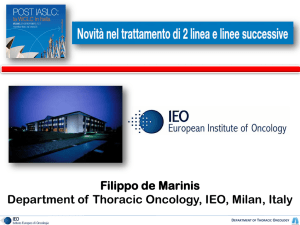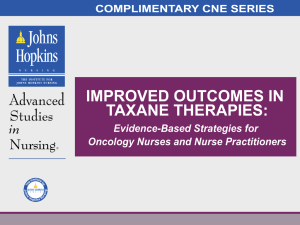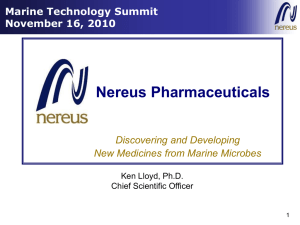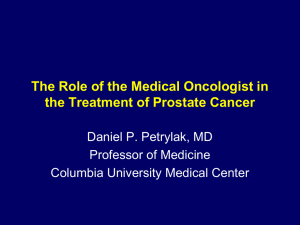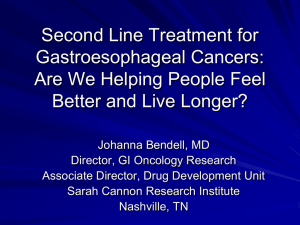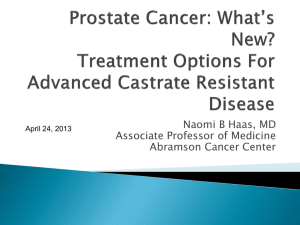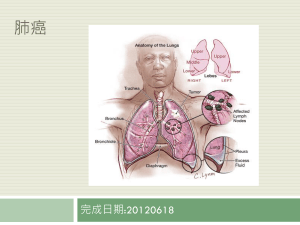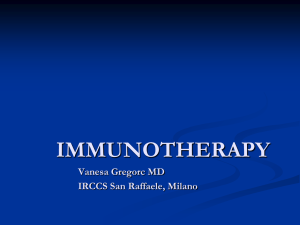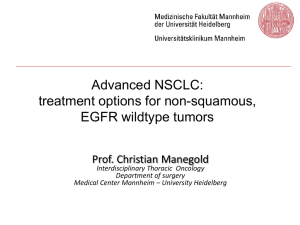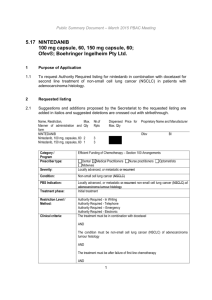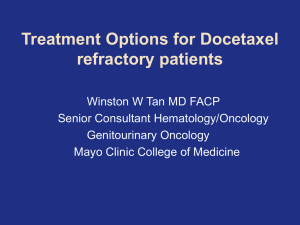LUME-Lung 1
advertisement
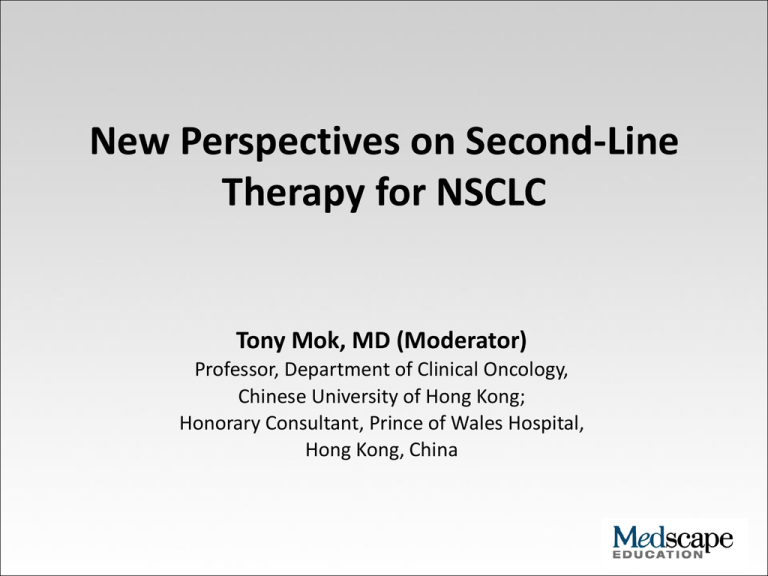
New Perspectives on Second-Line Therapy for NSCLC Tony Mok, MD (Moderator) Professor, Department of Clinical Oncology, Chinese University of Hong Kong; Honorary Consultant, Prince of Wales Hospital, Hong Kong, China Overview • Discuss the current standards of care for secondline therapy in patients with advanced NSCLC • Examine the unique and unmet needs of patients without targetable activating mutations • Review emerging research findings on second-line therapy in NSCLC and their implications for clinical practice NSCLC = non-small cell lung cancer Panelists Luis Paz-Ares Rodríguez, MD, PhD Martin Reck, MD, PhD Chair, Department of Oncology, Seville University Hospital, Seville, Spain Head, Department of Thoracic Oncology, Hospital Grosshansdorf, Grosshansdorf, Germany Single-Driver Mutations in NSCLC Lovly C, et al. http://www.mycancergenome.org/content/disease/lung-cancer. Pao W, Girard N. Lancet Oncol. 2011;12:175-180. NSCLC Without Targetable Mutations: An Unmet Need Lovly C, et al. http://www.mycancergenome.org/content/disease/lung-cancer. Pao W, Girard N. Lancet Oncol. 2011;12:175-180. NSCLC Histology Howlader N, et al (eds). SEER Cancer Statistics Review, 1975-2010, National Cancer Institute. Bethesda, MD, 2013. Single-Driver Mutations in NSCLC Gene Incidence KRAS 15% 25% EGFR 10% 35% ALK 3% 7% MET 2% 4% HER2 2% 4% BRAF 1% 3% PIK3CA 1% 3% AKT1 1% MAP2K1 1% NRAS 1% ROS1 1% RET 1% Lovly C, et al. http://www.mycancergenome.org/content/disease/lung-cancer. Pao W, Girard N. Lancet Oncol. 2011;12:175-180. Outcomes With First-Line Doublet Therapy: ECOG 1594 OS = overall survival; PFS = progression-free survival Schiller JH, et al. New Engl J Med. 2002;346:92-98. Months Outcomes With First-Line Triplet Therapy: ECOG 4599 Months CI = confidence interval; ECOG = Eastern Cooperative Oncology Group; HR = hazard ratio Sandler A, et al. New Engl J Med. 2006;355:2542-2550. Second-Line Therapy: Options & Outcomes Study TAX INTEREST[c] TITAN[d] 1-Year Survival Docetaxel (N = 103) 7.0 37.0% Best supportive care (N = 100) 4.6 12.0% Pemetrexed (N = 283) 8.3 29.7% Docetaxel (N = 288) 7.9 29.7% Gefitinib (N = 723) 7.6 32.0% Docetaxel (N = 710) 8.0 34.0% Erlotinib (N = 203) 5.3 26.0% Chemotherapy (N = 221: 116 docetaxel, 105 pemetrexed) 5.5 24.0% Treatment Arms 317[a] Hanna et al. Median OS (mos) 2004[b] a. Shepherd FA, et al. J Clin Oncol. 2000;18:2095-2103. b. Hanna N, et al. J Clin Oncol. 2004;22:1589-1597. c. Kim ES, et al. Lancet. 2008;372:1809-1818. d. Ciuleanu T, et al. Lancet Oncol. 2012;13:300-308. Second-Line Therapy: Grade 3/4 Toxicities Erlotinib[a] ≈ Pemetrexed[a,b] << Docetaxel[b] Percent Reporting 40.2% a. Vamvakas L, et al. ASCO 2010. b. Hanna N, et al. J Clin Oncol. 2004;22:1589-1597. Adverse Event Selecting Second-Line Therapy Patient Factors Treatment History • PS • Age • Patient preference • First-line regimen • Duration of response to firstline treatment Tumor Characteristics • • • • • Tumor burden Histology EGFR? ALK? KRAS? Good PS + good response to first-line chemo Chemotherapy Adenocarcinoma + targetable mutation/rearrangement Targeted therapy (erlotinib, gefitinib, crizotinib) Wild-type or KRAS mutations Chemotherapy PS = performance status Second-Line Therapy: Outstanding Needs • Options for patients with wild-type mutations (EGFR, etc) • Predictive biomarkers • New agents with efficacy in the second-line setting Second-Line Therapy: Research To Date Study Treatment Tax 317 BR.21 JMEI Docetaxel (D75/100) vs BSC Erlotinib vs placebo Pemetrexed vs docetaxel Tax 320 Docetaxel (D75/100) vs ifosfamide or vinorelbine ISEL Gefitinib vs placebo ZODIAC Vandetanib + docetaxel vs docetaxel ZEAL ZEST VITAL Vandetanib + pemetrexed vs pemetrexed Vandetanib vs erlotinib Aflibercept + docetaxel vs docetaxel BETA Bevacizumab + erlotinib vs erlotinib TAILOR Docetaxel vs erlotinib, non-EGFR mutations TITAN Docetaxel/pemetrexed vs erlotinib Vinflunine Topotecan SUN1087 Vinflunine vs docetaxel Oral topotecan vs docetaxel Sunitinib + erlotinib vs erlotinib Median OS (mo) 7.5 (D75) vs 4.6 6.7 vs 4.7 FAILED In pre-treated patients, only 2 out of 15 trials to date have shown an improvement in OS All of these trials are against placebo only (no active comparator arm). Direct comparison is not possible. List contains examples and is not exhaustive. Angiogenesis Inhibitors in NSCLC Target Drug EGFR Axitinib Bevacizumab* BMS-690514 Brivanib Cediranib Linifanib MGCD265 Motesanib FGFR PDGFR VEGF β VEGFR R-1, 2, 3 R-2 R-1, 2, 3 R-1, 2, 3 R-1, 2, 3 R-1 α/β Nintedanib R-1, 2, 3 α/β R-1, 2, 3 Pazopanib Sorafenib Sunitinib Vandetanib R-1, 3 α/β β α/β R-1, 2, 3 R-2, 3 R-1, 2, 3 R-2, 3 * Currently approved for first-line therapy of NSCLC, in combination with a platinum and taxane Ellis PM & Al-Saleh K. Critical Rev Onc/Hem. 2012;84:47-58. Angiogenesis Inhibitors in NSCLC: Nintedanib • Investigational oral agent • Can be combined with chemotherapy - Docetaxel[a] Pemetrexed[b] Paclitaxel/carboplatin[c] Gemcitabine/cisplatin[d] a. Bousquet G, et al. Br J Cancer. 2011;105:1640-1645. b. Ellis PM, et al. Clin Cancer Res. 2010;16:2881-2889. c. Doebele RC, et al. Ann Oncol. 2012;23:2094-2102. d. http://clinicaltrials.gov/show/NCT01346540. LUME-Lung 1: Trial Design Patients with NSCLC who have failed first-line chemotherapy Randomization Oral nintedanib + Chemotherapy (docetaxel) Second-line treatment Placebo + Chemotherapy (docetaxel) Number of docetaxel cycles not restricted Monotherapy with nintedanib/placebo allowed after ≥ 4 cycles Primary endpoint: PFS Key secondary endpoint: OS Results presented at ASCO 2013 Reck M, et al. ASCO 2013. LUME-Lung 1: Inclusion Criteria Inclusion criteria: • Male or female patients, aged ≥ 18 years • Patients with IIIB/IV or recurrent NSCLC (all histologies) • Progression after prior first-line chemotherapy • ECOG score of 0 and 1 1314 patients: recruitment completed Reck M, et al. ASCO 2013. LUME-Lung 1: PFS (All Patients) Probability of survival without progression (%) 100 Nintedanib + docetaxel Placebo + docetaxel (n = 655) (n = 659) 3.4 2.7 Median, mo 80 HR (95% CI) 0.79 (0.68 to 0.92) P 60 .0019 40 20 0 0 2 4 6 8 10 Time (months) Reck M, et al. ASCO 2013. 12 14 16 18 LUME-Lung 1: OS (All Patients) Probability of survival (%) 100 Nintedanib + docetaxel Placebo + docetaxel (n = 655) (n = 659) 10.1 9.1 Median, mo 80 HR (95% CI) 0.94 (0.83 to 1.05) P .2720 60 40 20 0 0 4 8 12 16 20 Time (months) Reck M, et al. ASCO 2013. 24 28 32 36 LUME-Lung 1: OS (Adenocarcinoma Patients) Probability of survival (%) 100 Nintedanib + docetaxel Placebo + docetaxel (n = 322) (n = 336) 12.6 10.3 Median, mo 80 HR (95% CI) 0.83 (0.70 to 0.99) P 60 .0359 52.7% 40 25.7% 44.7% 20 19.1% 0 0 4 8 12 16 20 Time (months) Reck M, et al. ASCO 2013. 24 28 32 36 LUME-Lung 1: Adverse Events of Special Interest Nintedanib + docetaxel Patients Reporting (%) Placebo + docetaxel Adverse Events, All Grades (incidence ≥ 15%) Reck M, et al. ASCO 2013. Adverse Events, Grade ≥ 3 (incidence ≥ 1%) LUME-Lung 1: Summary • Met primary endpoint of delaying tumour growth following failure of first-line therapy • Showed a significant survival benefit in patients with adenocarcinoma compared with an active comparator • Well tolerated with manageable safety profile OS (mo) Combination Therapy With Angiogenesis Inhibitors: First-Line vs Second-Line Outcomes HR, 0.79; 95% CI, 0.67 to 0.92 P = .003 [a] a. Sandler A, et al. New Engl J Med. 2006;355:2542-2550. b. Reck M, et al. J Clin Oncol. 2013;31(suppl): LBAS011. HR, 0.83; P = .0359 LUME-Lung 1[b] (Adenocarcinoma subset) LUME-Lung 1: OS by Histology 100 Median, mo Nintedanib + docetaxel (n = 655) Placebo + docetaxel (n = 659) 10.1 9.1 Median, mo 0.94 (0.83 to 1.05) HR (95% CI) Probability of survival (%) HR (95% CI) P 80 Nintedanib + docetaxel (n = 322) Placebo + docetaxel (n = 336) 12.6 10.3 0.83 (0.70 to 0.99) P .2720 .0359 60 40 20 0 0 4 8 12 16 20 24 All patients Reck M, et al. ASCO 2013. 28 32 36 0 4 8 12 16 20 24 28 Adenocarcinoma subset 32 36 Nintedanib in Squamous Cell Carcinoma: Outstanding Issues • Benefit demonstrated regarding PFS • OS benefit seen in patients with large tumors • Role of FGFR amplification in squamous cell carcinoma requires further investigation LUME-Lung 1: Toxicities Associated with VEGF/VEGFR Inhibitors Nintedanib + docetaxel Placebo + docetaxel All grades % Grade ≥ 3 % All grades % Grade ≥ 3 % Bleeding 14.1 2.3 11.6 1.8 Thromboembolism 5.1 2.1 4.6 3.1 Hypertension 3.5 0.2 0.9 0 VTE 2.8 1.2 1.5 1.1 ATE 0.6 0.5 1.4 0.6 GI perforation 0.5 0.2 0.5 0.5 Adverse event ATE = arterial thromboembolism; GI = gastrointestinal; VTE = venous thromboembolism Reck M, et al. ASCO 2013. Looking Forward: Research Needs • Combination vs monotherapy Biomarkers to assist in patient selection Role of clinical factors, histology, etc LUME-Lung 1: Characteristics Associated With Improved OS in Nintedanib-Treated Adenocarcinoma Patients Characteristic HR (95% CI) Prior bevacizumab .241 Yes 0.61 (0.31, 1.20) No 0.85 (0.71, 1.01) Best response to first-line therapy .189 CR/PR/SD 0.90 (0.73, 1.10) PD 0.62 (0.41, 0.94) Time since start of first-line therapy .419 < 9 months 0.75 (0.60, 0.92) ≥ 9 months 0.89 (0.66, 1.19) CR = complete response; PD = progressive disease; PR = partial response; SD = stable disease Reck M, et al. ASCO 2013. P value OS (mo) Angiogenesis Inhibitors in the Second-Line Setting: LUME-Lung 1 vs ZODIAC HR, 0.94 95% CI, 0.83 to 1.05 P = .2720 LUME-Lung 1[a] a. Reck M, et al. J Clin Oncol. 2013;31(suppl): LBAS011. b. Herbst RS, et al. Lancet Oncol. 2010;11:619-626. HR, 0.91 97.52% CI, 0.78 to 1.07 P = .196 [b] Angiogenesis Inhibitors in the Second-Line Setting: LUME-Lung 2 Entry Criteria • • • • • Stage IIB/IV or recurrent NSCLC Non-squamous histology Relapsed/failed one prior line of chemotherapy Measurable lesion(s) ECOG PS 0 or 1 Randomization 1:1 Nintedanib + pemetrexed Target enrollment: 1300 Placebo + pemetrexed (N = 353) (N = 360) Disease Progression Disease Progression • Study was halted after interim analysis suggested the primary endpoint of PFS would not be met • Ongoing patients were unblinded and follow-up continued per protocol Hanna NH, et al. ASCO 2013. Estimated patients alive and progression-free (%) LUME-Lung 2: Centrally-Reviewed PFS Median PFS, mo HR (95% CI) Nintedanib + pemetrexed Placebo + pemetrexed (n = 353) (n = 360) 4.4 3.6 0.83 (0.70 to 0.99) Log-rank p value Time from randomization (months) Hanna NH, et al. ASCO 2013. .0435 OS (mo) Docetaxel in the Second-Line Setting: Survival Trends TAX 317[a] Hanna et al. 2004[b] a. Shepherd FA, et al. J Clin Oncol. 2000;18:2095-2103. b. Hanna N, et al. J Clin Oncol. 2004;22:1589-1597. c. Kim ES, et al. Lancet. 2008;372:1809-1818. d. Herbst RS, et al. Lancet Oncol. 2010;11:619-626. e. Reck M, et al. ASCO 2013. INTEREST[c] ZODIAC[d] LUMELung 1[e] LUME-Lung 1: Patient Characteristics Characteristic Nintedanib + docetaxel (N = 655) Placebo + docetaxel (N = 659) Age < 65 years 69.5% 67.5% Current/former smoker 74.8% 75.6% Adenocarcinoma 49.2% 51.0% Squamous cell carcinoma 42.1% 42.2% Other 8.7% 6.7% Platinum 95.9% 96.5% Bevacizumab 4.1% 3.5% Histology Prior therapy Reck M, et al. ASCO 2013. Clinical Questions • Sequencing of therapy? • Treatment beyond progression? • Impact of maintenance therapy on subsequent treatment decisions? LUME-Lung 1: Characteristics Associated With Improved OS in Nintedanib-Treated Adenocarcinoma Patients Characteristic HR (95% CI) Prior bevacizumab .241 Yes 0.61 (0.31, 1.20) No 0.85 (0.71, 1.01) Best response to first-line therapy .189 CR/PR/SD 0.90 (0.73, 1.10) PD 0.62 (0.41, 0.94) Time since start of first-line therapy .419 < 9 months 0.75 (0.60, 0.92) ≥ 9 months 0.89 (0.66, 1.19) Reck M, et al. ASCO 2013. P value Take Home Messages • A majority of NSCLC patients do not have targetable mutations • Second-line treatment options for these patients have historically been limited • Combination therapy with the angiogenesis inhibitor bevacizumab has been successful in the first-line setting • In the second-line setting, combination therapy with the angiogenesis inhibitor nintedanib has recently been shown to Prolong PFS in patients with NSCLC, regardless of histology Improve OS in patients with adenocarcinoma Thank you for participating in this activity. To proceed to the Post-Test and Activity Evaluation, click on the Earn CME Credits link on this page.
